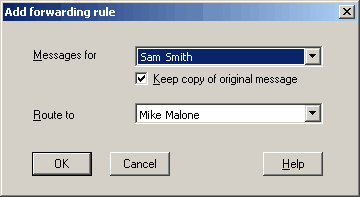![]()
Software configuration
Zetafax Configuration
Configuring the automatic routing options is done by the system administrator using Zetafax Configuration . The Automatic Inward Routing item (Server Settings folder) controls whether sub-address and/or sender ID routing will be used. They are enabled by default.
Additionally there is a separate Automatic Inward Routing item in the Zetafax folder itself, and this contains the rules that control inward routing.
You can configure each of the three types of routing listed below.
Adding a routing rule
To add a routing rule of any one of the three types:
•Click Automatic Inward Routing (Zetafax folder).
•Click the type of rule required - Sub-address, Sender ID, or Forwarding.
•On the Action menu, click Add.
•Fill in the rule dialog's controls.
•Click OK.
To edit an existing routing rule:
•Click the rule type item.
•In the right pane, click the rule.
•On the Action menu, click Edit.
•Make the required changes.
•Click OK.
Sub-address
The sub-address option configures the rules for DID and DTMF routing, as well as for the other sub-address options (Station Identifier Suffix and ITU sub-addressing).
Each rule comprises a sub-address and a user to route the message to. For DID routing the sub-address should be the number reported to the fax modem on answering (usually the extension number or last few digits of the phone number dialed).

For example, if user FRED has a DID number of 020 7378 4122, HARRY's DID number is 020 7378 4123, and HARRY is also looking after faxes directed to SALES (using the station ID suffix method), the rules might appear as:
4122 FRED
4123 HARRY
SALES HARRY
It is not necessary to add an explicit rule for each user if their name is specified in a station ID suffix; this is done automatically, though can be disabled by adding a blank rule for that name; i.e. routing to (none).
Sender ID
Sender ID rules store two pieces of information for each sender: the organization name, and the person to receive faxes from that sender. Both these items can be set from the Zetafax Client program as well as from the Zetafax Configuration program.
The organization name is used for labeling the message in the client's In window when a fax is received; for example, From: Smith and Sons instead of From: 012 345 9876.
Note: Changing the organization name using Zetafax Configuration affects only messages received from that time onwards.
The new person to receive the fax depends on whom it was originally sent to. For example, suppose you have two general fax numbers for SALES and ACCOUNTS. Faxes from Smith and Sons for SALES are being handled by FRED, while faxes from Smith and Sons for ACCOUNTS are looked after by JIM. The rules would then be:
SALES Smith and Sons (012 345 9876) to FRED
ACCOUNTS Smith and Sons (012 345 9876) to JIM
When adding rules using the Zetafax Configuration program you can set the Messages for field (the name of the person who originally received the fax) to (unaddressed ). This means that the rule will be applied to messages from that company sent to any user, rather than just for a specific user. Any rules for specific users are applied in preference to the general rule.
You can also have rules which just give the company name, without specifying a user to forward messages on to. These appear in the list with the two username fields left blank.
Generally most sender ID rules are added by the user who receives unaddressed incoming faxes, using the Zetafax Client program (see Use from the Zetafax Client). The Zetafax Configuration program is then used for reviewing and adjusting the rules when required.
Forwarding
The third routing option is for automatic forwarding when a user is away, such as on vacation. To configure this you specify the original recipient of the messages (the person going away), and the user to receive their faxes. For each rule configured, you can specify whether the original user keeps a copy of the original message (copied to in the list), instead of deleting the original (forwarded to).

For example, if messages for SUE and JIM are being looked after by MIKE and HARRY respectively, and SUE wants to keep a copy for her records while JIM does not, the rules would be:
SUE copied to MIKE
JIM forwarded to HARRY
Related topics